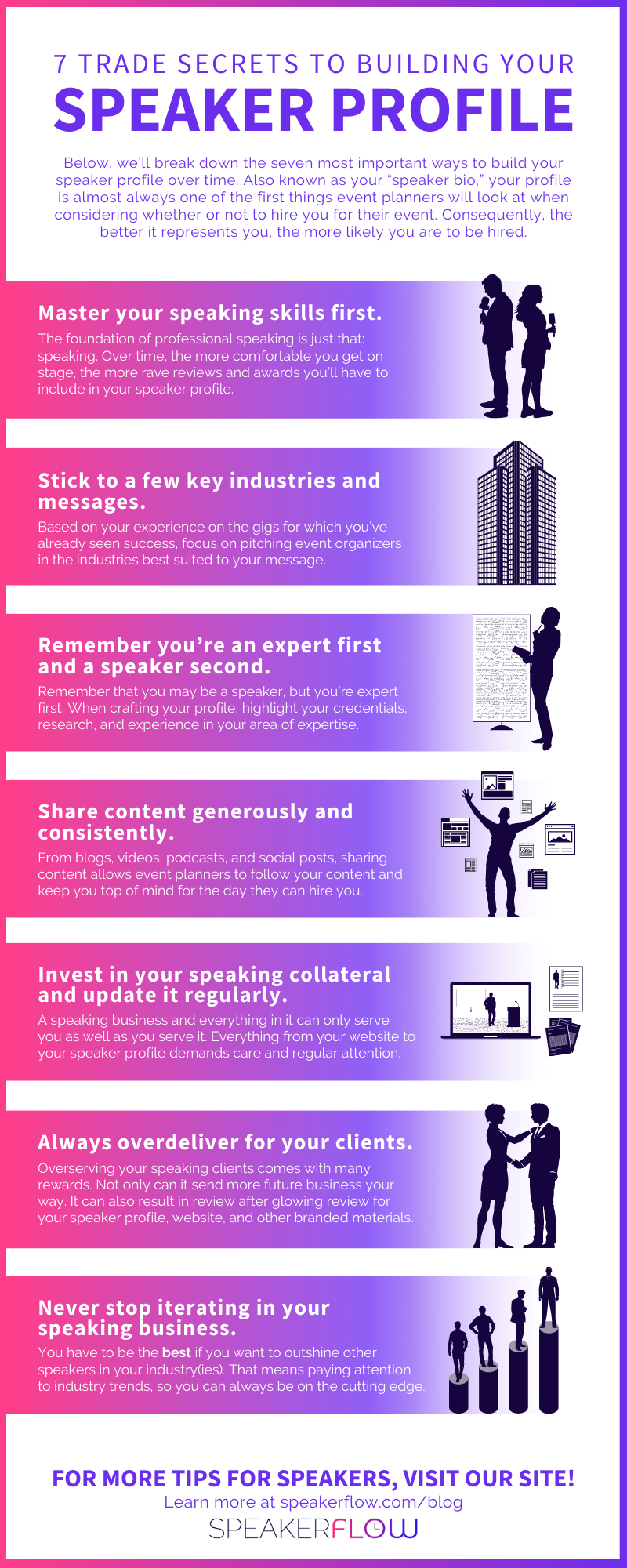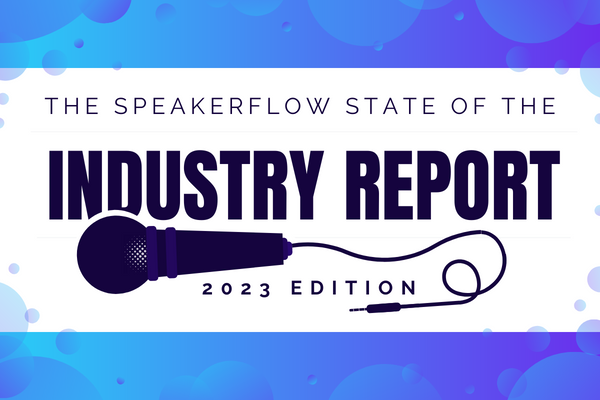As an increasingly diverse and quickly growing industry, professional speaking has never been more popular. Whether it’s part- or full-time and regardless of your message, speaking comes with a long list of benefits, including the opportunity to travel the world and share a message you’re passionate about, all while potentially making thousands of dollars per event. However, to build your speaking business to this point, developing a killer speaker profile is a key first step.
In this guide, we’ll break down the seven most important ways to build your speaker profile over time. Also known as your “speaker bio,” your profile is almost always one of the first things event planners will look at when considering whether or not to hire you for their event. Consequently, the better it represents you, the more likely you are to be hired.
We’ll also explain how building the rest of your business ties into your profile. After all, if your business is a well-oiled, cutting-edge machine, not only will that mean more sales coming through the door. It’ll also show that you don’t just talk the talk with your clients. You walk the walk, too, and can prove – with your own success – that your advice works.
Considering this, let’s get into the details, so you can start fine-tuning your speaker profile as soon as possible. 👇
- Master your speaking skills first.
- Stick to a few key industries and messages.
- Remember you’re an expert first and a speaker second.
- Share content generously and consistently.
- Invest in your speaking collateral and update it regularly.
- Always overdeliver for your clients.
- Never stop iterating in your speaking business.
Master your speaking skills first.
First – and maybe most obviously – make sure you’re comfortable speaking. We’ve all sat through a lecture or speech in which it was clear the speaker did not want to be on stage. Maybe they were nervous and kept fidgeting or stumbling over their words. Maybe they were unprepared or ran into technical problems with their presentation. Either way, it’s easy to tell which speakers know what they’re doing and which ones are new to the game. Your job is to convince your audience you’re the former, even if you’re not 100% comfortable on stage.

To do this, make it your mission to continually improve your speaking skills. You can accomplish this in various ways, but below are a few we’ve heard most frequently.
- Practice, practice, practice. Even if you’ve given 1,000 speeches already, every one will be different so practicing beforehand is crucial.
- Reach out to speakers you admire and offer a virtual coffee in exchange for their advice. Many successful speakers began with stage fright and have their own methods for building the confidence they have today.
- Stay on top of industry trends. What made for a good speech 20 years ago isn’t always applicable now, so make sure you know what is.
- When in doubt, ask for help! Whether it’s an online course or personal coaching, public speaking training is nothing to be ashamed of and can be well worth the fee.
Ultimately, the foundation of professional speaking is just that: speaking. Over time, the more comfortable you get on stage, the more rave reviews and awards you’ll have to include in your speaker profile. And I think we can all agree that “award-winning international speaker” will always make your profile stand out. 🏆
Stick to a few key industries and messages.
The next step to building your speaker profile is narrowing your focus. For many speakers, it can be tempting to approach as many industry events as possible that are suited to their presentations. If a component of your speeches is customer service, for example, it can be easy to jump right to, “Well, that applies to everyone!” A few other common examples are speeches on leadership, change management, or diversity. In some ways, this temptation is justified, too, as every industry can benefit from learning more about these topics.

That said, when you try to make your presentations well-suited to everyone, you end up diluting their value. What you might advise for one industry may not work in another. Even the speaking style you use in one industry may not work in others.
In the end, to make everyone happy, you can end up giving advice that’s not necessarily specific to your client. Plus, since you don’t specialize in anything, it will almost certainly get more and more difficult to prove to potential clients that you understand their needs and are the perfect fit for their event.
In order to avoid this, make a point of sticking to a few key industries. Based on your experience and advice and based on the gigs for which you’ve already seen success, ask yourself, “Which industries can benefit from my work the most?” and “Which industries am I most passionate about serving?” Then, focus on pitching event organizers in the industries that fit both of these questions.
Eventually, as you serve more clients within your these industries, you’ll be able to show, in your speaker profile, that you know them backwards and forwards. This makes it clear that you’re dedicated to serving them long-term and a perfect for their events. Win, win!
Remember you’re an expert first and a speaker second.
Step three of building your speaker profile is the other side of the professional speaking coin: your expertise. Part of being a speaker is getting on stage, sure. But, beyond that, speaking is about thought leadership and sharing ideas that, ultimately, help make the world a better place.

Let’s look at a few famous motivational speakers, for example. One of the most popular motivational speakers from the last few years is Bréne Brown. An expert on shame and empathy, Brown worked as a research professor at the University of Houston long before she branched into speaking. Another example is Gary Vaynerchuk, an entrepreneurial speaker and ecommerce guru. Like Brown, Vaynerchuk may be a speaker today, but he continues to work in the field that inspired his speaking career. He and Brown don’t just get up on stage and preach about what their audiences should and shouldn’t do to succeed. They live their values and advice day-in and day-out and continue to share their thoughts with fans when away from the stage.
Likewise, when building your own speaker profile, remember that you may be a speaker, but you’re expert first. This means that, when crafting your profile, make sure to highlight your credentials, research, and experience in your area of expertise. Think about how many years you’ve been working in it and what you’re most proud of accomplishing. Then, work them into your speaker profile for a confident but humble show of your intellectual strength.
Share content generously and consistently.
Besides your accolades and achievements, being an expert – while simultaneously building your speaker profile – also means sharing your expertise consistently. Like Bréne Brown and Gary Vaynerchuk, this means creating and disseminating content for your target audience. It also means doing so not just for a fee (like online courses), but also for free. That way, even if someone can’t hire you to speak just yet, they can follow your content and keep you top of mind for the day they can hire you.

Generally speaking, there are many different types of content for you to choose from. Among speakers, a few of the most popular are as follows:
- Blogs – This includes sharing blog articles on your own website or guest writing for other leaders in your focus industries. Our team recommends doing both.
- Podcasts – Like blogs, podcasting can be done under your own brand or by appearing on other podcasts in your industry. Although hosting your own can be useful, we generally suggest appearing on others’ podcasts to start with.
- YouTube Videos – Now more than ever, video content gains more traction than text. YouTube is a free and easy way for you to ride this trend wave.
- Social Media – Sharing content on social media is a great way to get in front of your audience where they’re already active. This includes running “live” videos, posting regularly, and interacting with your followers.
All of these marketing channels can be useful ways to attract fans and event organizers looking for speakers. Additionally, the more successful these channels are, the more clout they add to your speaker profile. Though they may seem insignificant at the time, sharing your own content and supporting other content creators in the industry is just another way to show your long-term dedication and skill.
Invest in your speaking collateral and update it regularly.
The next and fifth step to building your speaker profile is investing in yourself. Like any startup, a speaking business and everything in it can only serve you as well as you serve it.

Take a website, for example. If you only take 8 hours to build your website, there are going to be a few issues with it. It might be your wording, your branding, or the general navigation of the site itself. In any case, not investing enough time and energy into your website is going to result in something… well, something less than ideal, to put it nicely. Our own site definitely isn’t perfect, but we’ve spent hundreds of hours over the last two years refining it so that it best reflects our team and our mission.
In the same way, everything from your own website to your speaker profile demands care and attention. Although this can mean a large time and monetary investment, initially, it also means that each element of your speaking collateral will show you at your best. That way, even if an event planner hasn’t spoken to you yet, they’ll know simply from seeing your materials, “Wow, this person’s really got their sh*t together.” 👏
To get started, below is the basic list of speaking materials we recommend you prepare. For more suggestions, I highly recommend meeting with fellow speakers to see what additional items they’ve found to be helpful in building a speaking business.
Speaking Collateral Checklist:
- Professional Speaking Website
- Speaker Kit (includes your biography, program descriptions, testimonials, and contact information at minimum)
- Speaker Introduction (for use before your presentations)
- List of Audio/Visual Requirements (for live and virtual events)
- Slide Decks for Your Presentations (branded under your personal brand by default)
Always overdeliver for your clients.
Sixth in our list of speaker profile steps is a tried-and-true tactic: underpromise and overdeliver. Most speaking clients will automatically approach you with a set of assumptions and expectations. Some are about you and your speaking skills. Some are about your level of expertise and the value you can provide for their event. Your job is to blow all of those expectations out of the water every time.

One speaker that knows this better than most is Brittany Hodak. As a marketing professional and superfan expert, Hodak’s passion – and speaking focus – is teaching others how to turn their clients into brand advocates, starting with the experiences those clients have.
To hear her tell it, “The quickest way to elicit excited reactions is by exceeding your customers’ expectations every time you engage with them. When you do, they’ll be eager to expand their relationship with you… Expressing empathy is one way to exceed expectations; listening effectively is another.” In other words, the more you exceed clients’ expectations, the more likely they are to book you repeatedly for their events. They’re also more likely to recommend you to others in their industry, essentially selling on your behalf. What’s not to love about that, right? 🙌
Summarily, overserving your speaking clients comes with many rewards. Not only can it send more future business your way. It can also result in review after glowing review for your speaker profile, website, and other branded materials. All you have to do is keep your eye on the ball (i.e. focus on serving your client to the best of your ability).
Never stop iterating in your speaking business.

Finally, the last step in building your speaker profile is to never stop working to improve. I mentioned initially that the speaking industry is becoming increasingly diverse and wide-reaching. But, with these changes comes a long list of other things to consider if you want to stand out. You can’t simply be “good enough” anymore if you want to outshine other speakers in your industry(ies). You have to be the best. That means paying attention to industry trends in sales, marketing, and stagecraft, so you can always be on the cutting edge.
It’s also important to note that, whether you’re looking at your speaker profile, your website, or your presentations, no client loves the speaker that thinks they’re perfect. They love the speakers that partner with them to create great content and accept constructive criticism, even when it can be hard to hear. In your own speaking business, keep that in mind as you grow and remember there’s always room for all of us to improve.
Ultimately, these aren’t the only things you can do to build your speaker profile, they are some of the most impactful. With that in mind, hopefully, this guide helps save you some time, energy, money, and stress as you build your speaking business in the coming months.
For more information about building a speaking business, check our free Resources Library or podcast, Technically Speaking. Additionally, for advice tailored to your speaking business, book a call with our team to see how we can help you run it more efficiently – and more profitably – in the future. 💪







